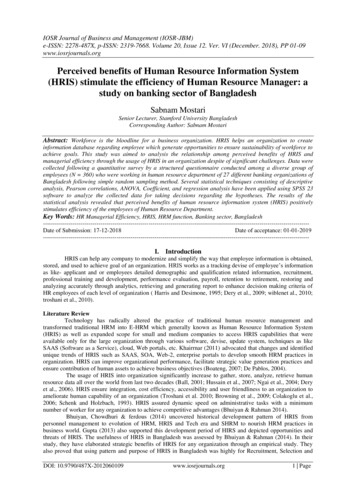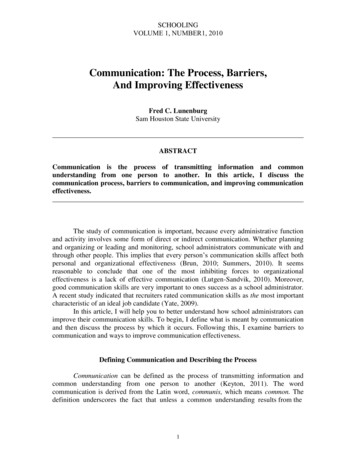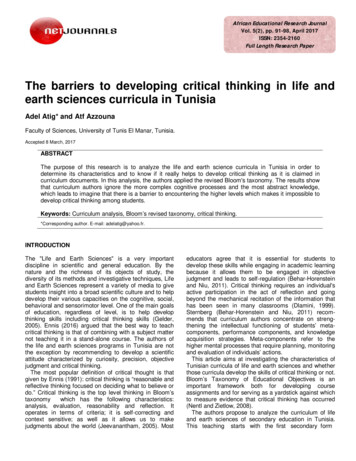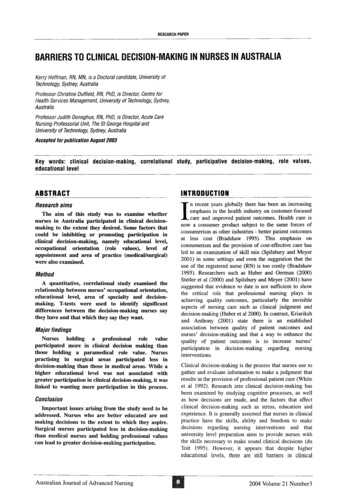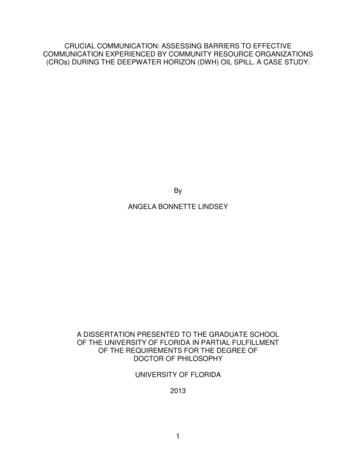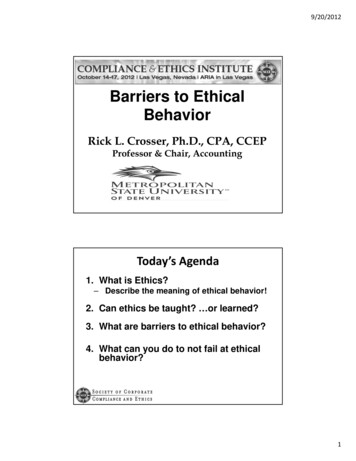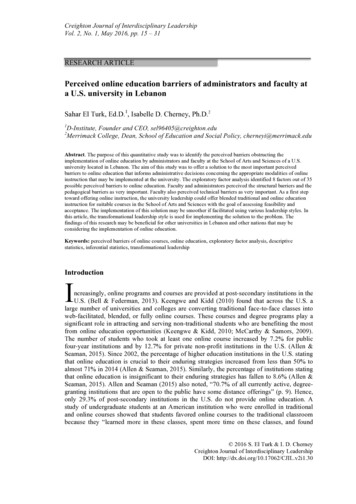
Transcription
Creighton Journal of Interdisciplinary LeadershipVol. 2, No. 1, May 2016, pp. 15 – 31RESEARCH ARTICLEPerceived online education barriers of administrators and faculty ata U.S. university in LebanonSahar El Turk, Ed.D.1, Isabelle D. Cherney, Ph.D.212D-Institute, Founder and CEO, sel96405@creighton.eduMerrimack College, Dean, School of Education and Social Policy, cherneyi@merrimack.eduAbstract. The purpose of this quantitative study was to identify the perceived barriers obstructing theimplementation of online education by administrators and faculty at the School of Arts and Sciences of a U.S.university located in Lebanon. The aim of this study was to offer a solution to the most important perceivedbarriers to online education that informs administrative decisions concerning the appropriate modalities of onlineinstruction that may be implemented at the university. The exploratory factor analysis identified 8 factors out of 35possible perceived barriers to online education. Faculty and administrators perceived the structural barriers and thepedagogical barriers as very important. Faculty also perceived technical barriers as very important. As a first steptoward offering online instruction, the university leadership could offer blended traditional and online educationinstruction for suitable courses in the School of Arts and Sciences with the goal of assessing feasibility andacceptance. The implementation of this solution may be smoother if facilitated using various leadership styles. Inthis article, the transformational leadership style is used for implementing the solution to the problem. Thefindings of this research may be beneficial for other universities in Lebanon and other nations that may beconsidering the implementation of online education.Keywords: perceived barriers of online courses, online education, exploratory factor analysis, descriptivestatistics, inferential statistics, transformational leadershipIntroductionIncreasingly, online programs and courses are provided at post-secondary institutions in theU.S. (Bell & Federman, 2013). Keengwe and Kidd (2010) found that across the U.S. alarge number of universities and colleges are converting traditional face-to-face classes intoweb-facilitated, blended, or fully online courses. These courses and degree programs play asignificant role in attracting and serving non-traditional students who are benefiting the mostfrom online education opportunities (Keengwe & Kidd, 2010; McCarthy & Samors, 2009).The number of students who took at least one online course increased by 7.2% for publicfour-year institutions and by 12.7% for private non-profit institutions in the U.S. (Allen &Seaman, 2015). Since 2002, the percentage of higher education institutions in the U.S. statingthat online education is crucial to their enduring strategies increased from less than 50% toalmost 71% in 2014 (Allen & Seaman, 2015). Similarly, the percentage of institutions statingthat online education is insignificant to their enduring strategies has fallen to 8.6% (Allen &Seaman, 2015). Allen and Seaman (2015) also noted, “70.7% of all currently active, degreegranting institutions that are open to the public have some distance offerings” (p. 9). Hence,only 29.3% of post-secondary institutions in the U.S. do not provide online education. Astudy of undergraduate students at an American institution who were enrolled in traditionaland online courses showed that students favored online courses to the traditional classroombecause they “learned more in these classes, spent more time on these classes, and found 2016 S. El Turk & I. D. CherneyCreighton Journal of Interdisciplinary LeadershipDOI: http://dx.doi.org/10.17062/CJIL.v2i1.30
16S. El Turk & I. D. Cherneythese classes to be more difficult yet of higher quality than traditional classes” (Keengwe &Kidd, 2010, p. 533).Some private universities in the U.S., such as Princeton University, Harvard University,Wellesley College, Amherst College, Yale University, and Stanford University, are stillrelatively resistant to offering 100% online instruction degrees. However, they are allincorporating online learning in the form of online courses to varying degrees (Brown, 2012;Harvard Extension School, 2014; Princeton University, 2014; Stanford University, 2014;Wellesley College, 2014; Yale University, 2014). For instance, students in the HarvardExtension School have the option of taking a combination of online and on-campus courses toearn a degree through the school’s video streaming distance education program (HarvardExtension School, 2014).Online education programs in the U.S. are considered the largest and most developed inthe world. Higher education institutions in the U.S. have progressively incorporated onlineeducation (Bonk & Kim, 2006; Morey, 2004). Unlike the U.S., online education has not beenwell received in the Middle East (Mirza & Abdulkareem, 2011).The following paragraphs present the history of online education in the United ArabEmirates (UAE) and Lebanon, and its level of adoption across the countries. Middle Easterncountries became late adopters of online education because their governments were lateadopters of the Internet (Mirza & Al-Abdulkareem, 2011). Governments, which originallyresisted the adoption of the Internet, later realized its importance and acquiesced to make theInternet available to their citizens after controlling access to undesired sites (Mirza & AlAbdulkareem, 2011). However, the incidence of primarily having online education in MiddleEastern countries is low in comparison with the U.S. (Spinks & Bedi, 2012). Some MiddleEastern countries, such as the UAE, are in the process of accepting online education andslowly recognizing the idea of it as a legitimate way to earn a degree in the Middle East(Spinks & Bedi, 2012). For instance, Hamdan Bin Mohammed e-University (HBMeU) hasemerged for the purpose of spreading online education. HBMeU was set up in 2002 as thefirst virtual institution in the Middle East (Spinks & Bedi, 2012). Additionally, U21Globaland the Syrian Virtual University, located in Dubai’s Knowledge Village, and the Universityof Liverpool/Laureate are known for providing online degrees in Dubai (Spinks & Bedi,2012). On October 23, 2013, the Minister of Higher Education and Scientific Research inUAE, Sheikh Hamdan bin Mubarak Al Nahyan, made a new decision about online highereducation that consisted of accepting interactive e-learning education as equivalent totraditional education programs and spreading online education in the country. The Ministerrequired that online education be interactive between instructors and students through theutilization of diverse sophisticated e-learning management systems (Emaratalyoum, 2014).Additionally, online degrees earned from other states would be certified and accepted by theMinistry of Education according to specific criteria including having an interactive e-learningsystem at the accredited university offering the online degrees (Emaratalyoum, 2014). In2014, the Ministry of Higher Education and Scientific Research in UAE released a list of 105accredited foreign online universities recommended for UAE students; 46 were in the UnitedKingdom, 34 were in the U.S., 20 were in Australia, and five were in New Zealand (TheNational, 2014).In Lebanon, online education is still not an option. The Lebanese government does notapprove any form of online degrees as an equivalent to traditional degrees. According to theofficial website of the Lebanese Ministry of Education and Higher Education, onlineeducation degrees are not accepted as equivalent to traditional degrees (Lebanese Ministry ofEducation and Higher Education, 2014). Despite this fact, the Arab Open University (AOU),an educational institution affiliated with the Open University in the United Kingdom, offers aLebanese degree that is accredited by the Lebanese Ministry of Education and HigherEducation and a British degree from the Open University in the United Kingdom (AOU,2014). The British degree is not accredited by the Ministry of Education and HigherEducation in Lebanon because it is online. Thus, holders of the British degree will not be able
Barriers to online education 17to work in Lebanon using this specific degree unless they hold a degree that was delivered inthe conventional form. There are over 30 public and private universities in Lebanon, none ofwhich offer any online degree programs (Lebanese Ministry of Education and HigherEducation, 2014). However, in 2007, the American University of Beirut (AUB) offered anonline graduate trial course, MECH798- Design Methodology (AUB, 2014).In Lebanon, there is no policy validating online degrees, but there are some attempts atintroducing online education. Despite not offering online degrees on its campus, AUB utilizedMoodle, an official learning management system, to teach Web-enhanced, blended, or onlinecourses (AUB, 2014). In 2013, the Lebanese American University (LAU) offered for the firsttime an elective graduate computer science course, Structural Bioinformatics, through theutilization of synchronous video conferencing (Khazen, personal communication, August 21,2014).To overcome barriers to online education, university leaders should carefully consider anumber of cultural and technical barriers to acceptance and instructional success before,during, and after seeking to implement solutions. They would need to know whatadministrators and faculty members think about online learning and which barriers mayinhibit implementation. Bass and Avolio (1993) mentioned that a new vision of anorganization could begin and develop when its leaders build a culture that is devoted tosupport that new vision. The university’s leaders need to be the change agents who will createa new vision to change the culture of the university and effectively articulate this change tofaculty, administrators, staff, and students. The university’s leadership includes executive,academic, and administrative officers. Leaders at the university are the first agents who acceptor reject any organizational change occurring at the university, and they are the ones whocreate and change university policies. McCarthy and Samors (2009) stated that the effectiveuse of online learning as a strategic instrument by academic institutions is a result of strongleadership and help from executive administrators. The leadership role at the university beingstudied here, the School of Arts and Sciences of a U.S. university located in Lebanon, iscrucial in the implementation process of online education in the curricula of the School ofArts and Sciences. Yang (2010) showed that administrators have long assumed their pivotalinfluence on school policies, faculty morale, and learning atmosphere. The responsibilities ofthe executive officers are critical to the prosperity and efficient functioning of any academicdepartment at the university under investigation in this study. Academic leaders in theirdisciplines are responsible for delivering their university’s strategic objectives throughproviding academic leadership in their disciplines, generating income via new activities,managing the delivery of their departments’ teaching methodologies, contributing to settingobjectives and priorities for the university, and supervising academic affairs. Administrativeleaders or directors of the university’s departments also have an important role in identifyingthe barriers to online education and providing an effective solution to overcoming theperceived barriers in order to have a successful implementation of online education at theuniversity.Thus, the purpose and aim of this study, respectively, based on dissertation research (ElTurk, 2015), were to identify the barriers to online education and to create and offer animplementation plan to overcome the most important perceived barriers at one university inLebanon.HypothesesTo identify the perceived barriers to online education, administrators and faculty at a U.S.university located in Lebanon were surveyed. The research question guiding this study was:What are the administrators’ and faculty members’ perceptions of barriers impeding theimplementation of online programs at the School of Arts and Sciences of the university understudy, and what must leaders do to overcome them?In the administrators’ data set, the following hypotheses were investigated: 2016 S. El Turk & I. D. CherneyCreighton Journal of Interdisciplinary LeadershipDOI: http://dx.doi.org/10.17062/CJIL.v2i1.30
18S. El Turk & I. D. CherneyHypothesis #1: The roles of administrators at the university affect the rating ofcultural barriers.Hypothesis #2: The roles of administrators at the university affect the rating ofstructural barriers.Hypothesis #3: The gender of administrators affects the rating of all extracted factors.Hypothesis #4: The administrative status of administrators affects the rating ofepistemological barriers.Hypothesis #5: The working experience of administrators affects the rating ofstructural barriers.thethethetheIn the faculty’s data set, the following hypotheses were investigated:Hypothesis #1: The gender of faculty affects the rating of all extracted factors.Hypothesis #2: The age of faculty affects the rating of the technical barriers.Hypothesis #3: The ranks of faculty affect the rating of the psychological barriers.Hypothesis #4: The status of faculty affects the rating of cost effectiveness analysisbarriers.Hypothesis #5: The experience with online education affects the rating of all extractedfactors.MethodologyInstrumentationNote: this first appeared as dissertation research (El Turk, 2015).Two questionnaires were developed based upon the barriers to online education identified inthe literature. These questionnaires were designed to survey participants about their perceivedbarriers impeding online education implementation at the university. The questionnaires werecreated in December 2014 with an online surve
Harvard Extension School, 2014; Princeton University, 2014; Stanford University, 2014; Wellesley College, 2014; Yale University, 2014). For instance, students in the Harvard Extension School have the option of taking a combination of online and on-campus courses to earn a degree through the school’s video streaming distance education program (Harvard Extension School, 2014). Online education .




